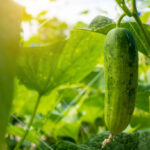
Welcome to Vego Garden’s comprehensive guide on how to grow tomatoes successfully. Tomatoes are not only known for their vibrant colors and freshness but also for their prolific yield and versatility in cooking. As experts in raised garden beds and vegetable cultivation, we are here to provide you with valuable insights, expert tips, and step-by-step instructions to help you grow the most delicious and abundant tomatoes in your own garden. Whether you are a beginner or an experienced gardener, this guide will equip you with the knowledge and techniques needed to achieve a successful tomato harvest.
Choosing the Right Tomato Variety
With approximately 10,000 tomato varieties available, it’s important to choose the right one for your specific needs and growing conditions. Tomatoes are often categorized as determinate or indeterminate, and selecting the appropriate type will greatly impact your gardening experience. Let’s explore these categories in detail:
Determinate Varieties: Also known as bush tomatoes, determinate varieties are more compact in size and stop growing when they reach a height of around 3 to 4 feet (approximately 0.9 to 1.2 meters). They produce buds, flower, and fruit over a two-week period before ceasing growth. These varieties are ideal for gardeners with limited space, as their compact nature allows for easy management and harvesting.
Indeterminate Varieties: If you have ample space and prefer vining tomatoes, indeterminate varieties are the way to go. These plants continue to grow and produce fruit until they are killed by frost. They require supports such as trellises or tomato cages to ensure proper growth and prevent sprawling. Indeterminate tomatoes can reach heights of up to 10 feet (approximately 3 meters) and have a longer growing period compared to determinate varieties.
Heirloom & Hybrid Varieties: Heirloom tomatoes are specialty varieties that have been grown without crossbreeding for 40 years or more. They often boast superior flavor but are more delicate and not suitable for long-distance shipping. Hybrid tomatoes, on the other hand, are mass-produced and commonly found in supermarkets. These tomatoes are a result of crossbreeding different cultivar types and are favored for their disease resistance, flavor, and extended storage capabilities. Experimenting with heirloom varieties can be a rewarding experience for experienced gardeners who enjoy unique flavors and characteristics.
In addition to these categories, there are various types of tomatoes to choose from, including cherry and grape tomatoes, Roma tomatoes (ideal for sauces and paste), and beefsteak tomatoes (perfect for slicing and sandwiches). Consider your taste preferences, cooking needs, and available space when selecting the right tomato variety for your garden.
Optimal Growing Conditions for Tomatoes
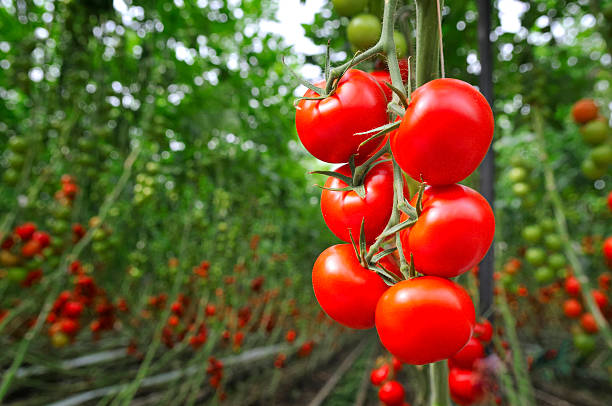
To ensure healthy growth and maximum yield, tomatoes require specific growing conditions. Paying attention to factors such as temperature, sunlight, soil quality, and watering practices will set the foundation for successful tomato cultivation. Let’s explore these conditions in detail:
Temperature: Tomatoes are warm-weather plants that thrive in temperatures between 55°F and 90°F (approximately 12°C to 32°C). Planting them when the temperature consistently stays above 55°F (approximately 13°C) is crucial for their survival and growth. In colder regions, you can start tomato seedlings indoors 6 to 8 weeks before the last spring frost date to get a head start. Avoid exposing tomatoes to temperatures below 50°F (10°C), as it inhibits their growth and can cause damage.
Sunlight: Tomatoes are sun-loving plants and require a minimum of 6 to 8 hours of direct sunlight daily. Choose a location in your garden that receives ample sunlight throughout the day. If you have limited sun exposure, consider using reflective materials or placing your tomatoes in raised beds or containers that can be moved to maximize sunlight exposure.
Soil Quality: Tomatoes thrive in well-draining, loose, and fertile soil. Aim for a sandy loam soil with good moisture retention and a pH level between 6.5 and 7. Incorporating organic matter, such as compost or aged manure, into the soil before planting will provide essential nutrients and improve soil structure. Avoid heavy clay soil, as it can lead to waterlogging and hinder root development.
Watering: Tomatoes require consistent and deep watering to maintain even soil moisture. Water deeply once or twice a week, depending on weather conditions. It’s essential to strike a balance and avoid overwatering or underwatering, as both can have detrimental effects on plant health. Mulching around the tomato plants with organic materials like straw or wood chips helps retain soil moisture and prevent weed growth.
Spacing: Proper spacing between tomato plants is crucial for adequate airflow and optimal growth. For determinate varieties, plant them approximately 2 feet (approximately 60cm) apart to allow for sufficient air circulation and easy access for maintenance. Indeterminate varieties can be planted slightly closer together, around 18 to 24 inches (approximately 45 to 60cm) apart. Proper spacing prevents overcrowding, reduces the risk of disease, and ensures that each plant receives adequate nutrients and sunlight.
By providing these optimal growing conditions, you will lay a solid foundation for your tomato plants to thrive and produce an abundant harvest.
Planting Tomatoes
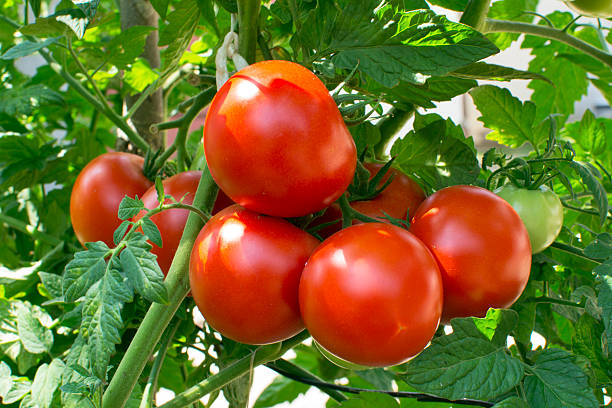
Now that you have selected the right tomato variety and prepared the growing conditions, it’s time to plant your tomatoes. Follow these steps to ensure a successful planting process:
1. Timing: Plant tomatoes outdoors when the danger of frost has passed and the soil temperature reaches 60°F (approximately 15°C). In colder regions, this is typically in late spring or early summer. If you prefer an early start, you can begin growing tomato seedlings indoors 6 to 8 weeks before the last spring frost date. Gradually expose the seedlings to outdoor conditions through a process called hardening off before transplanting.
2. Location: Choose a well-drained and sunny location in your garden for planting tomatoes. Raised garden beds are recommended, as they provide better control over soil quality and temperature fluctuations. Ensure the chosen location receives at least 6 to 8 hours of direct sunlight each day.
3. Soil Preparation: Before planting, prepare the soil by removing any weeds or debris. Incorporate organic matter, such as compost or well-rotted manure, into the soil to improve its fertility and structure. Ensure the soil is loose and well-draining.
4. Digging Holes: Dig holes for the tomato plants, making them deep enough to bury the stem up to the first set of leaves. This burying method encourages root development and helps establish sturdy plants.
5. Transplanting Seedlings: Gently remove the tomato seedlings from their containers, being careful not to damage the delicate roots. Place each seedling in a planting hole, ensuring the soil level reaches the first set of leaves. Backfill the hole with soil, gently firming it around the seedling. Water the plants immediately after transplanting to promote root establishment.
6. Supports: If you are growing indeterminate varieties, install supports such as trellises, stakes, or tomato cages at the time of planting. This will provide the necessary support as the plants grow and prevent them from sprawling on the ground.
7. Mulching: Apply a layer of organic mulch, such as straw or wood chips, around the tomato plants. Mulching helps retain soil moisture, suppress weed growth, and regulate soil temperature.
Following these planting steps willensure a successful start for your tomato plants and set them up for healthy growth and abundant fruit production.
Caring for Tomato Plants
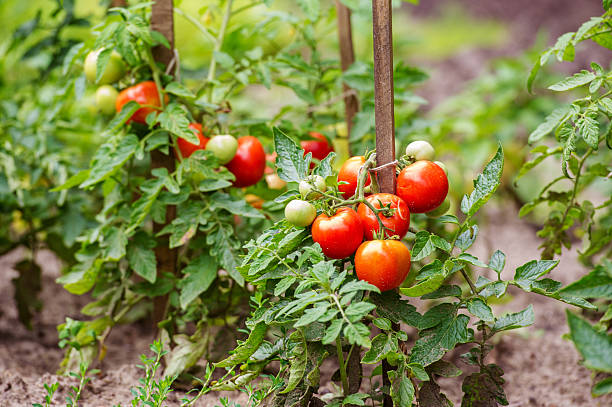
Once your tomato plants are in the ground, it’s important to provide them with proper care throughout the growing season. Here are some essential care tips to keep in mind:
Watering: Tomatoes require regular and consistent watering to maintain even soil moisture. Water deeply at the base of the plants to ensure the roots receive adequate moisture. Aim to provide about 1 to 1.5 inches of water per week, adjusting as needed based on weather conditions. Watering early in the day allows the foliage to dry before evening, reducing the risk of fungal diseases.
Fertilizing: Tomatoes are heavy feeders and benefit from regular fertilization. Prior to planting, incorporate compost or well-rotted manure into the soil to provide essential nutrients. As the plants grow, you can supplement with additional fertilizers. Choose a balanced organic fertilizer or a specific tomato fertilizer and follow the manufacturer’s instructions for application rates and frequency. Avoid excessive nitrogen fertilization, as it can lead to excessive foliage growth at the expense of fruit production.
Pruning and Training: Indeterminate tomato varieties benefit from pruning and training to improve air circulation, reduce disease risk, and promote larger fruit production. Pinch off suckers, which are the small shoots that grow between the main stem and side branches. Remove any damaged or diseased leaves to maintain plant health. As the plants grow, gently tie them to the trellises or supports to prevent them from sprawling on the ground.
Mulching: Maintain a layer of organic mulch around the tomato plants throughout the growing season. Mulch helps conserve soil moisture, regulate soil temperature, and suppress weed growth. Be sure to keep the mulch a few inches away from the plant stems to prevent rotting.
Pest and Disease Management: Tomatoes are susceptible to various pests and diseases, including aphids, cutworms, flea beetles, and fungal diseases like early blight and blossom-end rot. Regularly inspect your plants for signs of infestation or disease, and take appropriate action promptly. Consider using organic pest control methods such as handpicking pests, applying insecticidal soap or neem oil, and practicing crop rotation to minimize disease risks. Remove any diseased plant material from the garden to prevent the spread of pathogens.
Pollination: Tomatoes are self-pollinating plants, but they can benefit from additional pollination assistance. Gently shake the tomato plants or use a small brush to transfer pollen between flowers. This can help ensure proper fruit development and maximize yield.
Support and Prune: As your indeterminate tomato plants grow, continue to provide support and prune as needed. Monitor the growth and remove any excessive foliage that may hinder airflow and sunlight penetration. Pruning and proper support will improve overall plant health and encourage the development of larger, high-quality fruits.
By following these care instructions, you will provide your tomato plants with the optimal conditions they need to thrive and produce a bountiful harvest of delicious tomatoes.
Harvesting and Storing Tomatoes
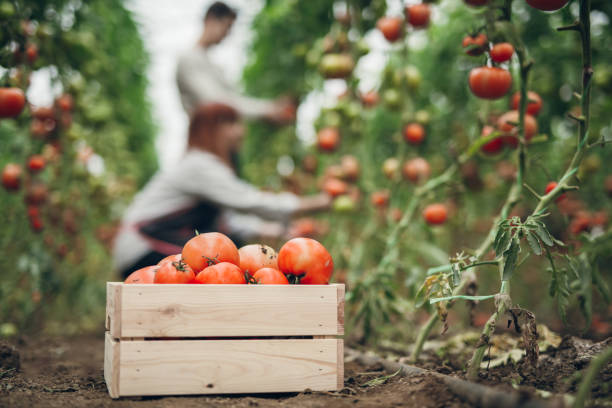
The moment you’ve been waiting for has arrived—the time to harvest your ripe and juicy tomatoes. Here’s how to do it right:
Harvesting: Tomatoes are ready for harvest when they have reached their mature color and are firm to the touch. Different varieties will have different color indicators of ripeness. For vine-ripened tomatoes, wait until they are fully ripe on the vine before harvesting. If you prefer to harvest them at a less ripe stage, when they are light orange or pink, you can do so to avoid splitting or damage, especially for indeterminate varieties. Gently squeeze the fruit to check for firmness and readiness. Use garden clippers or simply twist the tomatoes gently to detach them from the vine.
Storage: Proper storage is essential to maximize the shelf life and flavor of your harvested tomatoes. Avoid storing tomatoes in the refrigerator, as this can affect their flavor and texture. Instead, find a cool and shady location with good air circulation to store them. Ideally, the temperature should be between 65°F and 70°F (18°C to 21°C). Check your stored tomatoes regularly and use any ripe ones promptly. If you have an abundant harvest, consider preserving or canning tomatoes for future use.
Conclusion
Congratulations! You are now equipped with the knowledge and techniques to grow delicious and abundant tomatoes in your garden. By choosing the right tomato varieties, providing optimal growing conditions, and implementing proper care practices, you will enjoy a bountiful harvest of vibrant and flavorful tomatoes. Remember to water consistently, fertilize appropriately, support and prune indeterminate varieties, and address any pest or disease issues promptly. With dedication and attention to detail, your tomato plants will reward you with an abundance of juicy, homegrown tomatoes that will elevate your culinary creations. Happy gardening and enjoy your homegrown tomatoes!


